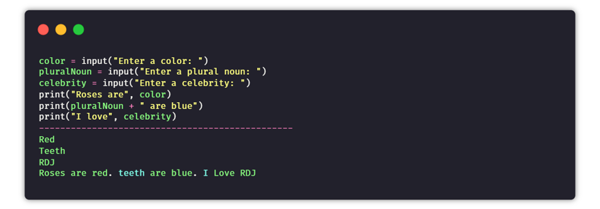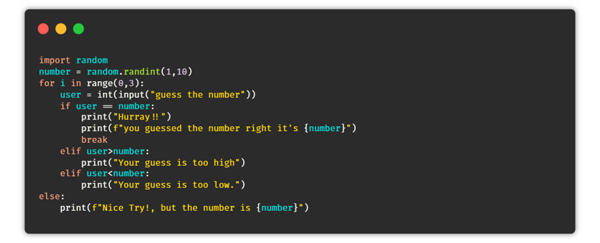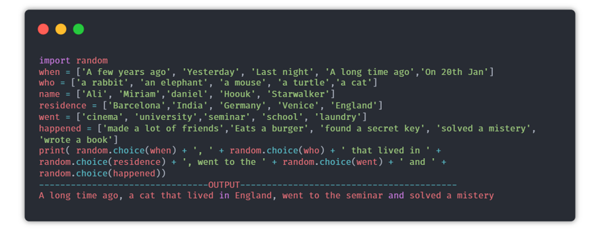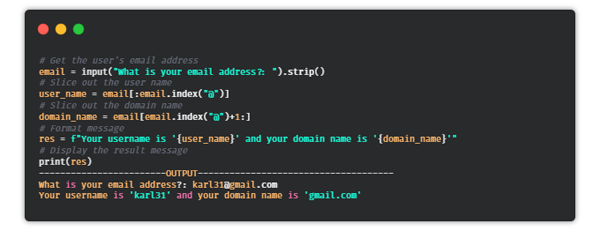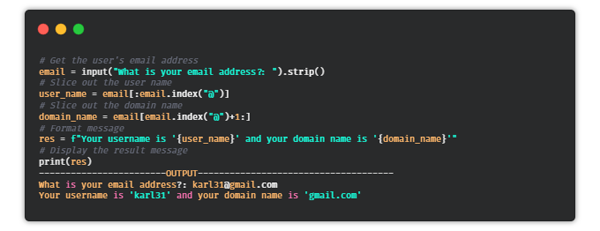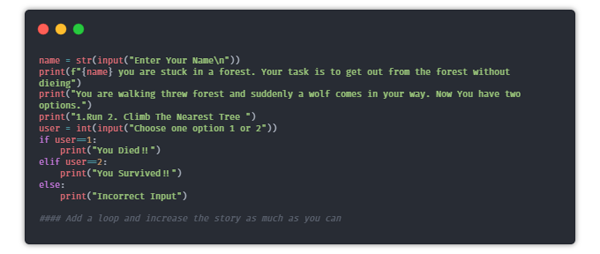建議收藏,22個Python迷你項目(附源碼)
在使用Python的過程中,我最喜歡的就是Python的各種第三方庫,能夠完成很多操作。
下面就給大家介紹22個通過Python構建的項目,以此來學習Python編程。
大家也可根據項目的目的及提示,自己構建解決方法,提高編程水平。
① 骰子模擬器
目的:創建一個程序來模擬擲骰子。
提示:當用戶詢問時,使用random模塊生成一個1到6之間的數字。
② 石頭剪刀布游戲
目標:創建一個命令行游戲,游戲者可以在石頭、剪刀和布之間進行選擇,與計算機PK。如果游戲者贏了,得分就會添加,直到結束游戲時,最終的分數會展示給游戲者。
提示:接收游戲者的選擇,并且與計算機的選擇進行比較。計算機的選擇是從選擇列表中隨機選取的。如果游戲者獲勝,則增加1分。
- import random
- choices = ["Rock", "Paper", "Scissors"]
- computer = random.choice(choices)
- player = False
- cpu_score = 0
- player_score = 0
- while True:
- player = input("Rock, Paper or Scissors?").capitalize()
- # 判斷游戲者和電腦的選擇
- if player == computer:
- print("Tie!")
- elif player == "Rock":
- if computer == "Paper":
- print("You lose!", computer, "covers", player)
- cpu_score+=1
- else:
- print("You win!", player, "smashes", computer)
- player_score+=1
- elif player == "Paper":
- if computer == "Scissors":
- print("You lose!", computer, "cut", player)
- cpu_score+=1
- else:
- print("You win!", player, "covers", computer)
- player_score+=1
- elif player == "Scissors":
- if computer == "Rock":
- print("You lose...", computer, "smashes", player)
- cpu_score+=1
- else:
- print("You win!", player, "cut", computer)
- player_score+=1
- elif player=='E':
- print("Final Scores:")
- print(f"CPU:{cpu_score}")
- print(f"Plaer:{player_score}")
- break
- else:
- print("That's not a valid play. Check your spelling!")
- computer = random.choice(choices)
③ 隨機密碼生成器
目標:創建一個程序,可指定密碼長度,生成一串隨機密碼。
提示:創建一個數字+大寫字母+小寫字母+特殊字符的字符串。根據設定的密碼長度隨機生成一串密碼。
④ 句子生成器
目的:通過用戶提供的輸入,來生成隨機且唯一的句子。
提示:以用戶輸入的名詞、代詞、形容詞等作為輸入,然后將所有數據添加到句子中,并將其組合返回。
⑤ 猜數字游戲
目的:在這個游戲中,任務是創建一個腳本,能夠在一個范圍內生成一個隨機數。如果用戶在三次機會中猜對了數字,那么用戶贏得游戲,否則用戶輸。
提示:生成一個隨機數,然后使用循環給用戶三次猜測機會,根據用戶的猜測打印最終的結果。
⑥ 故事生成器
目的:每次用戶運行程序時,都會生成一個隨機的故事。
提示:random模塊可以用來選擇故事的隨機部分,內容來自每個列表里。
⑦ 郵件地址切片器
目的:編寫一個Python腳本,可以從郵件地址中獲取用戶名和域名。
提示:使用@作為分隔符,將地址分為分為兩個字符串。
⑧ 自動發送郵件
目的:編寫一個Python腳本,可以使用這個腳本發送電子郵件。
提示:email庫可用于發送電子郵件。
- import smtplib
- from email.message import EmailMessage
- email = EmailMessage() ## Creating a object for EmailMessage
- email['from'] = 'xyz name' ## Person who is sending
- email['to'] = 'xyz id' ## Whom we are sending
- email['subject'] = 'xyz subject' ## Subject of email
- email.set_content("Xyz content of email") ## content of email
- with smtlib.SMTP(host='smtp.gmail.com',port=587)as smtp:
- ## sending request to server
- smtp.ehlo() ## server object
- smtp.starttls() ## used to send data between server and client
- smtp.login("email_id","Password") ## login id and password of gmail
- smtp.send_message(email) ## Sending email
- print("email send") ## Printing success message
⑨ 縮寫詞
目的:編寫一個Python腳本,從給定的句子生成一個縮寫詞。
提示:你可以通過拆分和索引來獲取第一個單詞,然后將其組合。
⑩ 文字冒險游戲
目的:編寫一個有趣的Python腳本,通過為路徑選擇不同的選項讓用戶進行有趣的冒險。
⑪ Hangman
目的:創建一個簡單的命令行hangman游戲。
提示:創建一個密碼詞的列表并隨機選擇一個單詞。現在將每個單詞用下劃線“_”表示,給用戶提供猜單詞的機會,如果用戶猜對了單詞,則將“_”用單詞替換。
- import time
- import random
- name = input("What is your name? ")
- print ("Hello, " + name, "Time to play hangman!")
- time.sleep(1)
- print ("Start guessing...\n")
- time.sleep(0.5)
- ## A List Of Secret Words
- words = ['python','programming','treasure','creative','medium','horror']
- word = random.choice(words)
- guesses = ''
- turns = 5
- while turns > 0:
- failed = 0
- for char in word:
- if char in guesses:
- print (char,end="")
- else:
- print ("_",end=""),
- failed += 1
- if failed == 0:
- print ("\nYou won")
- break
- guess = input("\nguess a character:")
- guesses += guess
- if guess not in word:
- turns -= 1
- print("\nWrong")
- print("\nYou have", + turns, 'more guesses')
- if turns == 0:
- print ("\nYou Lose")
⑫ 鬧鐘
目的:編寫一個創建鬧鐘的Python腳本。
提示:你可以使用date-time模塊創建鬧鐘,以及playsound庫播放聲音。
- from datetime import datetime
- from playsound import playsound
- alarm_time = input("Enter the time of alarm to be set:HH:MM:SS\n")
- alarm_hour=alarm_time[0:2]
- alarm_minute=alarm_time[3:5]
- alarm_seconds=alarm_time[6:8]
- alarm_period = alarm_time[9:11].upper()
- print("Setting up alarm..")
- while True:
- now = datetime.now()
- current_hour = now.strftime("%I")
- current_minute = now.strftime("%M")
- current_seconds = now.strftime("%S")
- current_period = now.strftime("%p")
- if(alarm_period==current_period):
- if(alarm_hour==current_hour):
- if(alarm_minute==current_minute):
- if(alarm_seconds==current_seconds):
- print("Wake Up!")
- playsound('audio.mp3') ## download the alarm sound from link
- break
⑬ 有聲讀物
目的:編寫一個Python腳本,用于將Pdf文件轉換為有聲讀物。
提示:借助pyttsx3庫將文本轉換為語音。
安裝:pyttsx3,PyPDF2
⑭ 天氣應用
目的:編寫一個Python腳本,接收城市名稱并使用爬蟲獲取該城市的天氣信息。
提示:你可以使用Beautifulsoup和requests庫直接從谷歌主頁爬取數據。
安裝:requests,BeautifulSoup
- from bs4 import BeautifulSoup
- import requests
- headers = {'User-Agent': 'Mozilla/5.0 (Windows NT 10.0; Win64; x64) AppleWebKit/537.36 (KHTML, like Gecko) Chrome/58.0.3029.110 Safari/537.3'}
- def weather(city):
- citycity=city.replace(" ","+")
- res = requests.get(f'https://www.google.com/search?q={city}&oq={city}&aqs=chrome.0.35i39l2j0l4j46j69i60.6128j1j7&sourceid=chrome&ie=UTF-8',headersheaders=headers)
- print("Searching in google......\n")
- soup = BeautifulSoup(res.text,'html.parser')
- location = soup.select('#wob_loc')[0].getText().strip()
- time = soup.select('#wob_dts')[0].getText().strip()
- info = soup.select('#wob_dc')[0].getText().strip()
- weather = soup.select('#wob_tm')[0].getText().strip()
- print(location)
- print(time)
- print(info)
- print(weather+"°C")
- print("enter the city name")
- city=input()
- citycity=city+" weather"
- weather(city)
⑮ 人臉檢測
目的:編寫一個Python腳本,可以檢測圖像中的人臉,并將所有的人臉保存在一個文件夾中。
提示:可以使用haar級聯分類器對人臉進行檢測。它返回的人臉坐標信息,可以保存在一個文件中。
安裝:OpenCV。
下載:haarcascade_frontalface_default.xml
- import cv2
- # Load the cascade
- face_cascade = cv2.CascadeClassifier('haarcascade_frontalface_default.xml')
- # Read the input image
- img = cv2.imread('images/img0.jpg')
- # Convert into grayscale
- gray = cv2.cvtColor(img, cv2.COLOR_BGR2GRAY)
- # Detect faces
- faces = face_cascade.detectMultiScale(gray, 1.3, 4)
- # Draw rectangle around the faces
- for (x, y, w, h) in faces:
- cv2.rectangle(img, (x, y), (x+w, y+h), (255, 0, 0), 2)
- crop_face = img[y:y + h, x:x + w]
- cv2.imwrite(str(w) + str(h) + '_faces.jpg', crop_face)
- # Display the output
- cv2.imshow('img', img)
- cv2.imshow("imgcropped",crop_face)
- cv2.waitKey()
⑯ 提醒應用
目的:創建一個提醒應用程序,在特定的時間提醒你做一些事情(桌面通知)。
提示:Time模塊可以用來跟蹤提醒時間,toastnotifier庫可以用來顯示桌面通知。
安裝:win10toast
- from win10toast import ToastNotifier
- import time
- toaster = ToastNotifier()
- try:
- print("Title of reminder")
- header = input()
- print("Message of reminder")
- text = input()
- print("In how many minutes?")
- time_min = input()
- time_min=float(time_min)
- except:
- header = input("Title of reminder\n")
- text = input("Message of remindar\n")
- time_min=float(input("In how many minutes?\n"))
- time_mintime_min = time_min * 60
- print("Setting up reminder..")
- time.sleep(2)
- print("all set!")
- time.sleep(time_min)
- toaster.show_toast(f"{header}",
- f"{text}",
- duration=10,
- threaded=True)
- while toaster.notification_active(): time.sleep(0.005)
⑰ 維基百科文章摘要
目的:使用一種簡單的方法從用戶提供的文章鏈接中生成摘要。
提示:你可以使用爬蟲獲取文章數據,通過提取生成摘要。
- from bs4 import BeautifulSoup
- import re
- import requests
- import heapq
- from nltk.tokenize import sent_tokenize,word_tokenize
- from nltk.corpus import stopwords
- url = str(input("Paste the url"\n"))
- num = int(input("Enter the Number of Sentence you want in the summary"))
- num = int(num)
- headers = {'User-Agent': 'Mozilla/5.0 (Windows NT 10.0; Win64; x64) AppleWebKit/537.36 (KHTML, like Gecko) Chrome/58.0.3029.110 Safari/537.3'}
- #url = str(input("Paste the url......."))
- res = requests.get(url,headersheaders=headers)
- summary = ""
- soup = BeautifulSoup(res.text,'html.parser')
- content = soup.findAll("p")
- for text in content:
- summary +=text.text
- def clean(text):
- text = re.sub(r"\[[0-9]*\]"," ",text)
- texttext = text.lower()
- text = re.sub(r'\s+'," ",text)
- text = re.sub(r","," ",text)
- return text
- summary = clean(summary)
- print("Getting the data......\n")
- ##Tokenixing
- sent_tokens = sent_tokenize(summary)
- summary = re.sub(r"[^a-zA-z]"," ",summary)
- word_tokens = word_tokenize(summary)
- ## Removing Stop words
- word_frequency = {}
- stopwords = set(stopwords.words("english"))
- for word in word_tokens:
- if word not in stopwords:
- if word not in word_frequency.keys():
- word_frequency[word]=1
- else:
- word_frequency[word] +=1
- maxmaximum_frequency = max(word_frequency.values())
- print(maximum_frequency)
- for word in word_frequency.keys():
- word_frequency[word] = (word_frequency[word]/maximum_frequency)
- print(word_frequency)
- sentences_score = {}
- for sentence in sent_tokens:
- for word in word_tokenize(sentence):
- if word in word_frequency.keys():
- if (len(sentence.split(" "))) <30:
- if sentence not in sentences_score.keys():
- sentences_score[sentence] = word_frequency[word]
- else:
- sentences_score[sentence] += word_frequency[word]
- print(max(sentences_score.values()))
- def get_key(val):
- for key, value in sentences_score.items():
- if val == value:
- return key
- key = get_key(max(sentences_score.values()))
- print(key+"\n")
- print(sentences_score)
- summary = heapq.nlargest(num,sentences_score,key=sentences_score.get)
- print(" ".join(summary))
- summary = " ".join(summary)
⑱ 獲取谷歌搜索結果
目的:創建一個腳本,可以根據查詢條件從谷歌搜索獲取數據。
- from bs4 import BeautifulSoup
- import requests
- headers = {'User-Agent': 'Mozilla/5.0 (Windows NT 10.0; Win64; x64) AppleWebKit/537.36 (KHTML, like Gecko) Chrome/58.0.3029.110 Safari/537.3'}
- def google(query):
- queryquery = query.replace(" ","+")
- try:
- url = f'https://www.google.com/search?q={query}&oq={query}&aqs=chrome..69i57j46j69i59j35i39j0j46j0l2.4948j0j7&sourceid=chrome&ie=UTF-8'
- res = requests.get(url,headersheaders=headers)
- soup = BeautifulSoup(res.text,'html.parser')
- except:
- print("Make sure you have a internet connection")
- try:
- try:
- ans = soup.select('.RqBzHd')[0].getText().strip()
- except:
- try:
- title=soup.select('.AZCkJd')[0].getText().strip()
- try:
- ans=soup.select('.e24Kjd')[0].getText().strip()
- except:
- ans=""
- ans=f'{title}\n{ans}'
- except:
- try:
- ans=soup.select('.hgKElc')[0].getText().strip()
- except:
- ans=soup.select('.kno-rdesc span')[0].getText().strip()
- except:
- ans = "can't find on google"
- return ans
- result = google(str(input("Query\n")))
- print(result)
獲取結果如下。
⑲ 貨幣換算器
目的:編寫一個Python腳本,可以將一種貨幣轉換為其他用戶選擇的貨幣。
提示:使用Python中的API,或者通過forex-python模塊來獲取實時的貨幣匯率。
安裝:forex-python
⑳ 鍵盤記錄器
目的:編寫一個Python腳本,將用戶按下的所有鍵保存在一個文本文件中。
提示:pynput是Python中的一個庫,用于控制鍵盤和鼠標的移動,它也可以用于制作鍵盤記錄器。簡單地讀取用戶按下的鍵,并在一定數量的鍵后將它們保存在一個文本文件中。
- from pynput.keyboard import Key, Controller,Listener
- import time
- keyboard = Controller()
- keys=[]
- def on_press(key):
- global keys
- #keys.append(str(key).replace("'",""))
- strstring = str(key).replace("'","")
- keys.append(string)
- main_string = "".join(keys)
- print(main_string)
- if len(main_string)>15:
- with open('keys.txt', 'a') as f:
- f.write(main_string)
- keys= []
- def on_release(key):
- if key == Key.esc:
- return False
- with listener(on_presson_press=on_press,on_releaseon_release=on_release) as listener:
- listener.join()
文章朗讀器
目的:編寫一個Python腳本,自動從提供的鏈接讀取文章。
- import pyttsx3
- import requests
- from bs4 import BeautifulSoup
- url = str(input("Paste article url\n"))
- def content(url):
- res = requests.get(url)
- soup = BeautifulSoup(res.text,'html.parser')
- articles = []
- for i in range(len(soup.select('.p'))):
- article = soup.select('.p')[i].getText().strip()
- articles.append(article)
- contents = " ".join(articles)
- return contents
- engine = pyttsx3.init('sapi5')
- voices = engine.getProperty('voices')
- engine.setProperty('voice', voices[0].id)
- def speak(audio):
- engine.say(audio)
- engine.runAndWait()
- contentcontents = content(url)
- ## print(contents) ## In case you want to see the content
- #engine.save_to_file
- #engine.runAndWait() ## In case if you want to save the article as a audio file
短網址生成器
目的:編寫一個Python腳本,使用API縮短給定的URL。
- from __future__ import with_statement
- import contextlib
- try:
- from urllib.parse import urlencode
- except ImportError:
- from urllib import urlencode
- try:
- from urllib.request import urlopen
- except ImportError:
- from urllib2 import urlopen
- import sys
- def make_tiny(url):
- request_url = ('http://tinyurl.com/api-create.php?' +
- urlencode({'url':url}))
- with contextlib.closing(urlopen(request_url)) as response:
- return response.read().decode('utf-8')
- def main():
- for tinyurl in map(make_tiny, sys.argv[1:]):
- print(tinyurl)
- if __name__ == '__main__':
- main()
- -----------------------------OUTPUT------------------------
- python url_shortener.py https://www.wikipedia.org/
- https://tinyurl.com/buf3qt3
以上就是今天分享的內容,針對上面這些項目,有的可以適當調整。
比如自動發送郵件,可以選擇使用自己的QQ郵箱。
天氣信息也可使用國內一些免費的API,維基百科可以對應百度百科,谷歌搜索可以對應百度搜索等等。
這些都是大伙可以思考的~

















